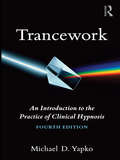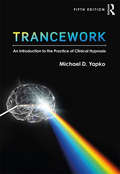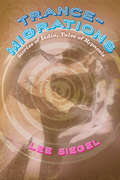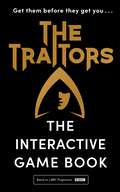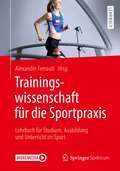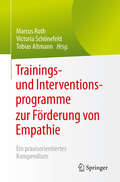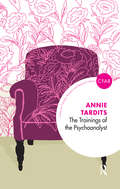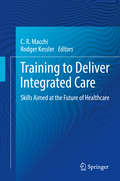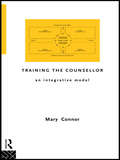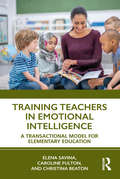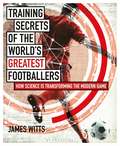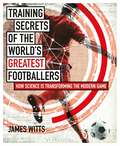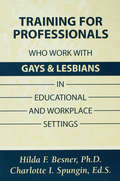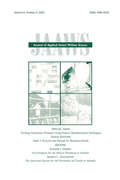- Table View
- List View
Trancework: An Introduction to the Practice of Clinical Hypnosis
by Michael D. YapkoFor three decades, Trancework has been the fundamental textbook for guiding professionals in learning hypnosis. Now in its fourth edition, this classic text continues to be the most comprehensive book for learning the fundamental skills of the field. This edition accommodates new studies and topics, and contains five new chapters on positive psychology, the management of pain, pediatric and adolescent hypnosis, behavioral medicine, and hypnosis across modalities. Readers can expect to receive a comprehensive overview of what is currently going on in the domain of hypnosis, an in-depth consideration of issues associated with the use of hypnosis, a greater appreciation for the diverse ways in which hypnosis can be applied, and a more detailed description of hypnotic methods and characteristics. Those new to the field will also appreciate the “Frames of Reference” sections found throughout the book, which provide insights into the work of some of the founders and leaders of clinical hypnosis. Each chapter concludes with suggestions from the author for things to consider and things to do, further emphasizing the importance of active learning. Included online at http://www.routledgementalhealth.com/books/details/9780415884945/ is the video of Dr. Yapko’s session with Vicki, an emotionally powerful and technically excellent session. For those who wish to follow along, a PDF download containing the session transcript is also available. Clinical Hypnosis has the power to change clients’ lives for the better. Trancework gives professionals the skills to do just that.
Trancework: An Introduction to the Practice of Clinical Hypnosis
by Michael D. YapkoFor three decades, Trancework has been the fundamental textbook for guiding professionals in learning hypnosis. Now in its fourth edition, this classic text continues to be the most comprehensive book for learning the fundamental skills of the field. This edition accommodates new studies and topics, and contains five new chapters on positive psychology, the management of pain, pediatric and adolescent hypnosis, behavioral medicine, and hypnosis across modalities. Readers can expect to receive a comprehensive overview of what is currently going on in the domain of hypnosis, an in-depth consideration of issues associated with the use of hypnosis, a greater appreciation for the diverse ways in which hypnosis can be applied, and a more detailed description of hypnotic methods and characteristics. Those new to the field will also appreciate the “Frames of Reference” sections found throughout the book, which provide insights into the work of some of the founders and leaders of clinical hypnosis. Each chapter concludes with suggestions from the author for things to consider and things to do, further emphasizing the importance of active learning. Included online at http://www.routledgementalhealth.com/books/details/9780415884945/ is the video of Dr. Yapko’s session with Vicki, an emotionally powerful and technically excellent session. For those who wish to follow along, a PDF download containing the session transcript is also available. Clinical Hypnosis has the power to change clients’ lives for the better. Trancework gives professionals the skills to do just that.
Trancework: An Introduction to the Practice of Clinical Hypnosis
by Michael D Yapko Michael D. YapkoFor nearly four decades, Trancework has been the definitive textbook for thousands of professionals undergoing training in the art and science of clinical hypnosis. Now in its 5th edition, this classic text continues its legacy of encouraging sound clinical practice based in established scientific research. This latest edition incorporates new studies and emerging topics within the field of hypnosis, including new chapters on depression and the construction of process-oriented interventions. Readers can expect to receive a comprehensive overview of current developments in the domain of hypnosis, an in-depth consideration of the practical and ethical issues associated with its use, and a greater appreciation for its many therapeutic applications. This thorough, engaging text equips professionals with the essential skills to change clients’ lives by using hypnosis to enhance treatment of both medical and psychological issues.
Trancework: An Introduction to the Practice of Clinical Hypnosis
by Michael D Yapko Michael D. YapkoFor nearly four decades, Trancework has been the definitive textbook for thousands of professionals undergoing training in the art and science of clinical hypnosis. Now in its 5th edition, this classic text continues its legacy of encouraging sound clinical practice based in established scientific research. This latest edition incorporates new studies and emerging topics within the field of hypnosis, including new chapters on depression and the construction of process-oriented interventions. Readers can expect to receive a comprehensive overview of current developments in the domain of hypnosis, an in-depth consideration of the practical and ethical issues associated with its use, and a greater appreciation for its many therapeutic applications. This thorough, engaging text equips professionals with the essential skills to change clients’ lives by using hypnosis to enhance treatment of both medical and psychological issues.
Trance-Migrations: Stories of India, Tales of Hypnosis
by Lee SiegelListen to what I am about to tell you: do not read this book alone. You really shouldn’t. In one of the most playful experiments ever put between two covers, every other section of Trance-Migrations prescribes that you read its incantatory tales out loud to a lover, friend, or confidant, in order to hypnotize in preparation for Lee Siegel’s exploration of an enchanting India. To read and hear this book is to experience a particular kind of relationship, and that’s precisely the point: hypnosis, the book will demonstrate, is an essential aspect of our most significant relationships, an inherent dimension of love, religion, medicine, politics, and literature, a fundamental dynamic between lover and beloved, deity and votary, physician and patient, ruler and subject, and, indeed, reader and listener. Even if you can’t read this with a partner—and I stress that you certainly ought to—you will still be in rich company. There is Shambaraswami, an itinerant magician, hypnotist, and storyteller to whom villagers turn for spells that will bring them wealth or love; José-Custodio de Faria, a Goan priest hypnotizing young and beautiful women in nineteenth-century Parisian salons; James Esdaile, a Scottish physician for the East India Company in Calcutta, experimenting on abject Bengalis with mesmerism as a surgical anesthetic; and Lee Siegel, a writer traveling in India to learn all that he can about hypnosis, yoga, past life regressions, colonialism, orientalism, magic spells, and, above all, the power of story. And then there is you: descending through these histories—these tales within tales, trances within trances, dreams within dreams—toward a place where the distinctions between reverie and reality dissolve. Here the world within the book and that in which the book is read come startlingly together. It’s one of the most creative works we have ever published, a dazzling combination of literary prowess, scholarly erudition, and psychological exploration—all tempered by warm humor and a sharp wit. It is informing, entertaining, and, above all, mesmerizing.
Trance-Migrations: Stories of India, Tales of Hypnosis
by Lee SiegelListen to what I am about to tell you: do not read this book alone. You really shouldn’t. In one of the most playful experiments ever put between two covers, every other section of Trance-Migrations prescribes that you read its incantatory tales out loud to a lover, friend, or confidant, in order to hypnotize in preparation for Lee Siegel’s exploration of an enchanting India. To read and hear this book is to experience a particular kind of relationship, and that’s precisely the point: hypnosis, the book will demonstrate, is an essential aspect of our most significant relationships, an inherent dimension of love, religion, medicine, politics, and literature, a fundamental dynamic between lover and beloved, deity and votary, physician and patient, ruler and subject, and, indeed, reader and listener. Even if you can’t read this with a partner—and I stress that you certainly ought to—you will still be in rich company. There is Shambaraswami, an itinerant magician, hypnotist, and storyteller to whom villagers turn for spells that will bring them wealth or love; José-Custodio de Faria, a Goan priest hypnotizing young and beautiful women in nineteenth-century Parisian salons; James Esdaile, a Scottish physician for the East India Company in Calcutta, experimenting on abject Bengalis with mesmerism as a surgical anesthetic; and Lee Siegel, a writer traveling in India to learn all that he can about hypnosis, yoga, past life regressions, colonialism, orientalism, magic spells, and, above all, the power of story. And then there is you: descending through these histories—these tales within tales, trances within trances, dreams within dreams—toward a place where the distinctions between reverie and reality dissolve. Here the world within the book and that in which the book is read come startlingly together. It’s one of the most creative works we have ever published, a dazzling combination of literary prowess, scholarly erudition, and psychological exploration—all tempered by warm humor and a sharp wit. It is informing, entertaining, and, above all, mesmerizing.
Trance-Migrations: Stories of India, Tales of Hypnosis
by Lee SiegelListen to what I am about to tell you: do not read this book alone. You really shouldn’t. In one of the most playful experiments ever put between two covers, every other section of Trance-Migrations prescribes that you read its incantatory tales out loud to a lover, friend, or confidant, in order to hypnotize in preparation for Lee Siegel’s exploration of an enchanting India. To read and hear this book is to experience a particular kind of relationship, and that’s precisely the point: hypnosis, the book will demonstrate, is an essential aspect of our most significant relationships, an inherent dimension of love, religion, medicine, politics, and literature, a fundamental dynamic between lover and beloved, deity and votary, physician and patient, ruler and subject, and, indeed, reader and listener. Even if you can’t read this with a partner—and I stress that you certainly ought to—you will still be in rich company. There is Shambaraswami, an itinerant magician, hypnotist, and storyteller to whom villagers turn for spells that will bring them wealth or love; José-Custodio de Faria, a Goan priest hypnotizing young and beautiful women in nineteenth-century Parisian salons; James Esdaile, a Scottish physician for the East India Company in Calcutta, experimenting on abject Bengalis with mesmerism as a surgical anesthetic; and Lee Siegel, a writer traveling in India to learn all that he can about hypnosis, yoga, past life regressions, colonialism, orientalism, magic spells, and, above all, the power of story. And then there is you: descending through these histories—these tales within tales, trances within trances, dreams within dreams—toward a place where the distinctions between reverie and reality dissolve. Here the world within the book and that in which the book is read come startlingly together. It’s one of the most creative works we have ever published, a dazzling combination of literary prowess, scholarly erudition, and psychological exploration—all tempered by warm humor and a sharp wit. It is informing, entertaining, and, above all, mesmerizing.
Trance-Migrations: Stories of India, Tales of Hypnosis
by Lee SiegelListen to what I am about to tell you: do not read this book alone. You really shouldn’t. In one of the most playful experiments ever put between two covers, every other section of Trance-Migrations prescribes that you read its incantatory tales out loud to a lover, friend, or confidant, in order to hypnotize in preparation for Lee Siegel’s exploration of an enchanting India. To read and hear this book is to experience a particular kind of relationship, and that’s precisely the point: hypnosis, the book will demonstrate, is an essential aspect of our most significant relationships, an inherent dimension of love, religion, medicine, politics, and literature, a fundamental dynamic between lover and beloved, deity and votary, physician and patient, ruler and subject, and, indeed, reader and listener. Even if you can’t read this with a partner—and I stress that you certainly ought to—you will still be in rich company. There is Shambaraswami, an itinerant magician, hypnotist, and storyteller to whom villagers turn for spells that will bring them wealth or love; José-Custodio de Faria, a Goan priest hypnotizing young and beautiful women in nineteenth-century Parisian salons; James Esdaile, a Scottish physician for the East India Company in Calcutta, experimenting on abject Bengalis with mesmerism as a surgical anesthetic; and Lee Siegel, a writer traveling in India to learn all that he can about hypnosis, yoga, past life regressions, colonialism, orientalism, magic spells, and, above all, the power of story. And then there is you: descending through these histories—these tales within tales, trances within trances, dreams within dreams—toward a place where the distinctions between reverie and reality dissolve. Here the world within the book and that in which the book is read come startlingly together. It’s one of the most creative works we have ever published, a dazzling combination of literary prowess, scholarly erudition, and psychological exploration—all tempered by warm humor and a sharp wit. It is informing, entertaining, and, above all, mesmerizing.
Trance-Migrations: Stories of India, Tales of Hypnosis
by Lee SiegelListen to what I am about to tell you: do not read this book alone. You really shouldn’t. In one of the most playful experiments ever put between two covers, every other section of Trance-Migrations prescribes that you read its incantatory tales out loud to a lover, friend, or confidant, in order to hypnotize in preparation for Lee Siegel’s exploration of an enchanting India. To read and hear this book is to experience a particular kind of relationship, and that’s precisely the point: hypnosis, the book will demonstrate, is an essential aspect of our most significant relationships, an inherent dimension of love, religion, medicine, politics, and literature, a fundamental dynamic between lover and beloved, deity and votary, physician and patient, ruler and subject, and, indeed, reader and listener. Even if you can’t read this with a partner—and I stress that you certainly ought to—you will still be in rich company. There is Shambaraswami, an itinerant magician, hypnotist, and storyteller to whom villagers turn for spells that will bring them wealth or love; José-Custodio de Faria, a Goan priest hypnotizing young and beautiful women in nineteenth-century Parisian salons; James Esdaile, a Scottish physician for the East India Company in Calcutta, experimenting on abject Bengalis with mesmerism as a surgical anesthetic; and Lee Siegel, a writer traveling in India to learn all that he can about hypnosis, yoga, past life regressions, colonialism, orientalism, magic spells, and, above all, the power of story. And then there is you: descending through these histories—these tales within tales, trances within trances, dreams within dreams—toward a place where the distinctions between reverie and reality dissolve. Here the world within the book and that in which the book is read come startlingly together. It’s one of the most creative works we have ever published, a dazzling combination of literary prowess, scholarly erudition, and psychological exploration—all tempered by warm humor and a sharp wit. It is informing, entertaining, and, above all, mesmerizing.
Trance-Migrations: Stories of India, Tales of Hypnosis
by Lee SiegelListen to what I am about to tell you: do not read this book alone. You really shouldn’t. In one of the most playful experiments ever put between two covers, every other section of Trance-Migrations prescribes that you read its incantatory tales out loud to a lover, friend, or confidant, in order to hypnotize in preparation for Lee Siegel’s exploration of an enchanting India. To read and hear this book is to experience a particular kind of relationship, and that’s precisely the point: hypnosis, the book will demonstrate, is an essential aspect of our most significant relationships, an inherent dimension of love, religion, medicine, politics, and literature, a fundamental dynamic between lover and beloved, deity and votary, physician and patient, ruler and subject, and, indeed, reader and listener. Even if you can’t read this with a partner—and I stress that you certainly ought to—you will still be in rich company. There is Shambaraswami, an itinerant magician, hypnotist, and storyteller to whom villagers turn for spells that will bring them wealth or love; José-Custodio de Faria, a Goan priest hypnotizing young and beautiful women in nineteenth-century Parisian salons; James Esdaile, a Scottish physician for the East India Company in Calcutta, experimenting on abject Bengalis with mesmerism as a surgical anesthetic; and Lee Siegel, a writer traveling in India to learn all that he can about hypnosis, yoga, past life regressions, colonialism, orientalism, magic spells, and, above all, the power of story. And then there is you: descending through these histories—these tales within tales, trances within trances, dreams within dreams—toward a place where the distinctions between reverie and reality dissolve. Here the world within the book and that in which the book is read come startlingly together. It’s one of the most creative works we have ever published, a dazzling combination of literary prowess, scholarly erudition, and psychological exploration—all tempered by warm humor and a sharp wit. It is informing, entertaining, and, above all, mesmerizing.
The Traitors: The Interactive Game Book
by Alan Connor'Great Christmas present… this book is brilliant' Zoe Ball, BBC Radio 2It's time to start your adventure. Get them before they get you.Put your sleuthing skills to the test in a world of deception, betrayal, and strategy. Placed in a castle in the Scottish Highlands, you must figure out if your fellow players are Faithful or a Traitor. Can you trust Jorge, the dentist with an encyclopaedic memory and tendency to smile at everyone? Or Nina, the retiree who acts like the group's matriarch but has a knowing glint in her eyes..? Beware, for in this treacherous game, trust is a luxury you cannot afford.In the official book of the BAFTA-winning phenomenon, The Traitors: The Interactive Game Book, the decisions you make will decide what happens next. Take this thrilling journey on your own or with others, pooling your wisdom to make the right choices. With over 20 standalone games to play as a pair or in a group - all with cunning Traitors twists - this is the perfect gift, guaranteed to unleash hours of mischief and fun.
Trainingswissenschaft für die Sportpraxis: Lehrbuch für Studium, Ausbildung und Unterricht im Sport
by Alexander FerrautiDieses motivierende und reichhaltig illustrierte Lehrbuch wendet sich an Studierende im Fach Sportwissenschaft sowie an Trainer, Auszubildende und Schüler in sport- und fitnessbezogenen Berufen und dient diesen als ideale Prüfungsvorbereitung. Es ist besonders geeignet als Begleit- und Vertiefungslektüre für Vorlesungen im Fach Trainingswissenschaft.Trainingswissenschaftliche Themen werden anschaulich, gut verständlich und praxisrelevant dargestellt. Auch interessierte Leistungs- und Freizeitsportlerinnen und -sportler erhalten eine ausgewogene Mischung von evidenzbasierten sportwissenschaftlichen Erkenntnissen und praktischen Trainingstipps.Wertvolle Hinweise zu den Bereichen Leistungsdiagnostik, Trainingssteuerung, Monitoring und Wettkampfanalyse bilden das Rückgrat des Buches. Das Grundlagenwissen zum Kraft-, Schnelligkeits-, Beweglichkeits-, Ausdauer- und Techniktraining wird durch angemessene biologische Vertiefungen und durch Exkurse zu modernen Trainingsinterventionen erweitert. Dem klaren Plädoyer für Individualisierung und Sportartspezifität des Trainings wurde durch gesonderte Kapitel zu ausgewählten Sportarten Rechnung getragen. Neben dem Leistungssport, stehen auch die Besonderheiten des Trainings mit Kindern und Jugendlichen, mit Aktiven im mittleren Lebensalter oder mit älteren Masterathletinnen und -athleten im Fokus. Das Buch wagt den Spagat zwischen einer international ausgerichteten forschungsorientierten Trainingswissenschaft und der unweigerlich damit verknüpften Sportpraxis. Abgerundet wird das didaktische Konzept durch interaktives Zusatzmaterial in Form von Videobeispielen, die einfach mit der Springer Nature More Media App abgerufen werden können.
Trainings- und Interventionsprogramme zur Förderung von Empathie: Ein praxisorientiertes Kompendium
by Marcus Roth Victoria Schönefeld Tobias AltmannDer Leser erhält mit diesem Werk eine breite Übersicht über die diversen Möglichkeiten, Empathie in der Praxis zu fördern. Das „Besondere“ besteht dabei einerseits in dem Umstand, dass alle Darstellungen den gleichen Aufbau aufweisen, wodurch ein direkter Vergleich ermöglicht und eine entsprechende Auswahl für eigene Zwecke erleichtert wird. Eine weitere Besonderheit besteht darin, dass die Programme aus völlig unterschiedlichen Bereichen stammen und so ein Blick „über den Tellerrand“ des eigenen Bereichs ermöglicht wird. So kann beispielsweise ein Anwender, der ursprünglich an einem Training für aggressive Jugendliche interessiert ist, aus Programmen zur Empathie-Förderung bei Grundschülern oder aber zum empathischen Umgang in sozialen Berufen Ideen übernehmen, an die er ursprünglich nicht gedacht hat, die er aber für seine aktuellen Zwecke als brauchbar einschätzt.Das Buch richtet sich an Psychologen, Berater und Therapeuten, Anwenderinnen und Anwender in der Fort- und Weiterbildung, Fach- und Führungskräfte in diversen Gesundheitsberufen sowie in der pädagogischen Arbeit, die Empathie als eine Schlüsselkompetenz erkannt haben und fördern wollen. Darüber hinaus ist es für Studierende der Psychologie, Pädagogik und der sozialen Berufe geeignet.
The Trainings of the Psychoanalyst (The Centre for Freudian Analysis and Research Library (CFAR))
by Annie TarditsIf psychoanalysis, for freud, was an impossible profession, what consequences would this have for psychoanalytic training? and if one’s own personal analysis lay at the heart of psychoanalytic training, how could what one had learnt from this be transmitted, let alone taught? In this groundbreaking book, annie Tardits explores the many attempts that analysts have made to think through the problems of psychoanalytic training. Moving from freud and his first students through to Lacan and his invention of the “pass”, Tardits charts the changing conceptions of psychoanalytic training. With clarity and elegance, she shows how different ideas of what psychoanalysis is will have effects on how training is understood. If psychoanalysis involves each person’s unique unravelling of the unconscious and of sexuality, what kind of training would be appropriate, or even possible?
The Trainings of the Psychoanalyst (The Centre for Freudian Analysis and Research Library (CFAR))
by Annie TarditsIf psychoanalysis, for freud, was an impossible profession, what consequences would this have for psychoanalytic training? and if one’s own personal analysis lay at the heart of psychoanalytic training, how could what one had learnt from this be transmitted, let alone taught? In this groundbreaking book, annie Tardits explores the many attempts that analysts have made to think through the problems of psychoanalytic training. Moving from freud and his first students through to Lacan and his invention of the “pass”, Tardits charts the changing conceptions of psychoanalytic training. With clarity and elegance, she shows how different ideas of what psychoanalysis is will have effects on how training is understood. If psychoanalysis involves each person’s unique unravelling of the unconscious and of sexuality, what kind of training would be appropriate, or even possible?
Training to Deliver Integrated Care: Skills Aimed at the Future of Healthcare
by C. R. Macchi Rodger KesslerThis unique trainer’s resource offers a comprehensive blueprint for preparing clinicians for practice in the changing and challenging environment of integrated care. Based firmly in new evidence-based models of behavioral care in medicine, it sets out the aims and objectives of modern integrated care delivery in a streamlined pedagogy-to-practice framework. Teaching strategies for developing core skills and competencies, suitable across diverse educational and workforce development settings, are presented with data-based rationales and guidelines for design and implementation. Chapters also cover the range of essentials, from research support to business acumen to program evaluation methods, needed to meet bedrock goals of improved quality of care, clinical outcomes, and patient satisfaction. The book’s comprehensive coverage: Reviews the evidence base for integrating medical and behavioral care.Provides empirically sound guidelines for training learners in integrated practice.Breaks down skill development into critical training objectives.Offers detailed content of a current degree program in integrative behavioral medicine.Recommends measures to support responsive, patient-centered, and sustainable training programs. A robust guide to a more inclusive and effective future, Training to Deliver Integrated Care expands the healthcare horizon to accommodate trainers working in health psychology, general practice, primary care medicine, and consulting, as well as supervision and coaching professionals.
Training the Counsellor: An Integrative Model
by Mary ConnorIn Training the Counsellor, Mary Connor shares a decade of training experience to provide an invaluable resource for other counsellor trainers. The role of the trainer as facilitator, educator and assessor as well as key professional and ethical issues are all brought vividly to life through many case examples. The focal point of the book is the integrative, four-stage model for training competent and reflective counsellors, with the relationship between trainee and client at the core of the model. The four stages are: the development of attitudes and values; knowledge and skills; client work and supervision; reflection and evaluation. Building on this model and drawing on her own wealth of experience, the author explore the interface between being professional and being human. Training the Counsellor, offers stimulating reading and tested guidelines for good practice for all those involved in training other helping professionals.
Training the Counsellor: An Integrative Model
by Mary ConnorIn Training the Counsellor, Mary Connor shares a decade of training experience to provide an invaluable resource for other counsellor trainers. The role of the trainer as facilitator, educator and assessor as well as key professional and ethical issues are all brought vividly to life through many case examples. The focal point of the book is the integrative, four-stage model for training competent and reflective counsellors, with the relationship between trainee and client at the core of the model. The four stages are: the development of attitudes and values; knowledge and skills; client work and supervision; reflection and evaluation. Building on this model and drawing on her own wealth of experience, the author explore the interface between being professional and being human. Training the Counsellor, offers stimulating reading and tested guidelines for good practice for all those involved in training other helping professionals.
Training Teachers in Emotional Intelligence: A Transactional Model For Elementary Education
by Elena Savina Caroline Fulton Christina BeatonTraining Teachers in Emotional Intelligence provides pre- and in-service teachers with foundational knowledge and skills regarding their own and their students’ emotions. Teachers are increasingly charged with providing social-emotional learning, responding to emotional situations in the classroom, and managing their own stress, all of which have real consequences for their retention and student achievement. Focused on the primary/elementary level, this book is an accessible review of children’s emotional development, the role of emotions in learning, teaching, and teachers’ professional identity. The book provides strategies for teachers to foster their emotional awareness, use emotions to promote learning and relationships, foster emotional competencies in students, and stay emotionally healthy.
Training Teachers in Emotional Intelligence: A Transactional Model For Elementary Education
by Elena Savina Caroline Fulton Christina BeatonTraining Teachers in Emotional Intelligence provides pre- and in-service teachers with foundational knowledge and skills regarding their own and their students’ emotions. Teachers are increasingly charged with providing social-emotional learning, responding to emotional situations in the classroom, and managing their own stress, all of which have real consequences for their retention and student achievement. Focused on the primary/elementary level, this book is an accessible review of children’s emotional development, the role of emotions in learning, teaching, and teachers’ professional identity. The book provides strategies for teachers to foster their emotional awareness, use emotions to promote learning and relationships, foster emotional competencies in students, and stay emotionally healthy.
Training Secrets of the World's Greatest Footballers: How Science is Transforming the Modern Game
by James WittsLooking at every area of the game and with exclusive contributions from elite players, leading coaches and sports scientists from the world's leading clubs – including Barcelona, Real Madrid, Manchester United, Chelsea, Paris St Germain and Bayern Munich – this expert guide reveals how sports science ensures the likes of Cristiano Ronaldo, Lionel Messi and Gareth Bale deliver super-star performances every time. A brilliant combination of locker-room secrets and practical advice, this is a book that will interest both players and fans.
Training Secrets of the World's Greatest Footballers: How Science is Transforming the Modern Game
by James WittsLooking at every area of the game and with exclusive contributions from elite players, leading coaches and sports scientists from the world's leading clubs – including Barcelona, Real Madrid, Manchester United, Chelsea, Paris St Germain and Bayern Munich – this expert guide reveals how sports science ensures the likes of Cristiano Ronaldo, Lionel Messi and Gareth Bale deliver super-star performances every time. A brilliant combination of locker-room secrets and practical advice, this is a book that will interest both players and fans.
Training Professionals Who Work With Gays and Lesbians in Educational and Workplace Settings
by Hilda Besner Charlotte I. SpunginFirst published in 1998. Routledge is an imprint of Taylor & Francis, an informa company.
Training Professionals Who Work With Gays and Lesbians in Educational and Workplace Settings
by Hilda Besner Charlotte I. SpunginFirst published in 1998. Routledge is an imprint of Taylor & Francis, an informa company.
Training Nonhuman Primates Using Positive Reinforcement Techniques: A Special Issue of the journal of Applied Animal Welfare Science
by Mark J. Prescott Hannah M. Buchanan-SmithThis special issue illustrates benefits to animals from positive reinforcement training (PRT) and--depending on the setting--to scientists, animal care staff, veterinarians, and in the case of the zoo, the visiting public. One important theme throughout is that training is a joint venture between human and nonhuman primate and can lead to a closer, richer relationship between the two. In summary, the editors hope this issue encourages further and wider application of PRT to primate management, care, and use, as well as aid those working with animals in applying PRT safely and effectively.
